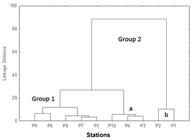Abstract
This work reviews the limnology of the largest multi-use reservoir in NE Brazil, the Castanhão Reservoir in Ceará State, during 5 years of an extended drought when the reservoir’s volume decreased from 88% to about 30%. Major physical and chemical parameters of the water column, phytoplankton community, trophic state and sediment geochemistry were monitored, as well as the impact from extensive aquaculture. Water quality of the full reservoir was maintained due to hydrodynamics, which transport nutrients to the hypolimnion of a stratified water column, rendering an oligotrophic state to the reservoir, notwithstanding the large nutrient inputs from aquaculture and irrigated agriculture. However, with the extension of the drought period, the reservoir volume reduced, decreasing water depth leading to breaking of the thermocline due to wind forcing, and mixing the entire water column. This increased turbidity, nutrient availability and primary productivity, also changed phytoplankton functional groups. As a result, at the end of the monitoring period, when the reservoir attained its lowest volume, its trophic state became eutrophic. Under a scenario of climate change, where annual precipitation is decreasing, human uses of reservoirs in the semiarid should be very restricted to maintain water quality proper for human use.
Key words
Hydrochemistry; hydrodynamics; nutrients; water quality; sediments; aquaculture

 Thumbnail
Thumbnail
 Thumbnail
Thumbnail
 Thumbnail
Thumbnail
 Thumbnail
Thumbnail
 Thumbnail
Thumbnail
 Thumbnail
Thumbnail
 Thumbnail
Thumbnail
 Thumbnail
Thumbnail
 Thumbnail
Thumbnail
 Thumbnail
Thumbnail
 Thumbnail
Thumbnail
 Thumbnail
Thumbnail











